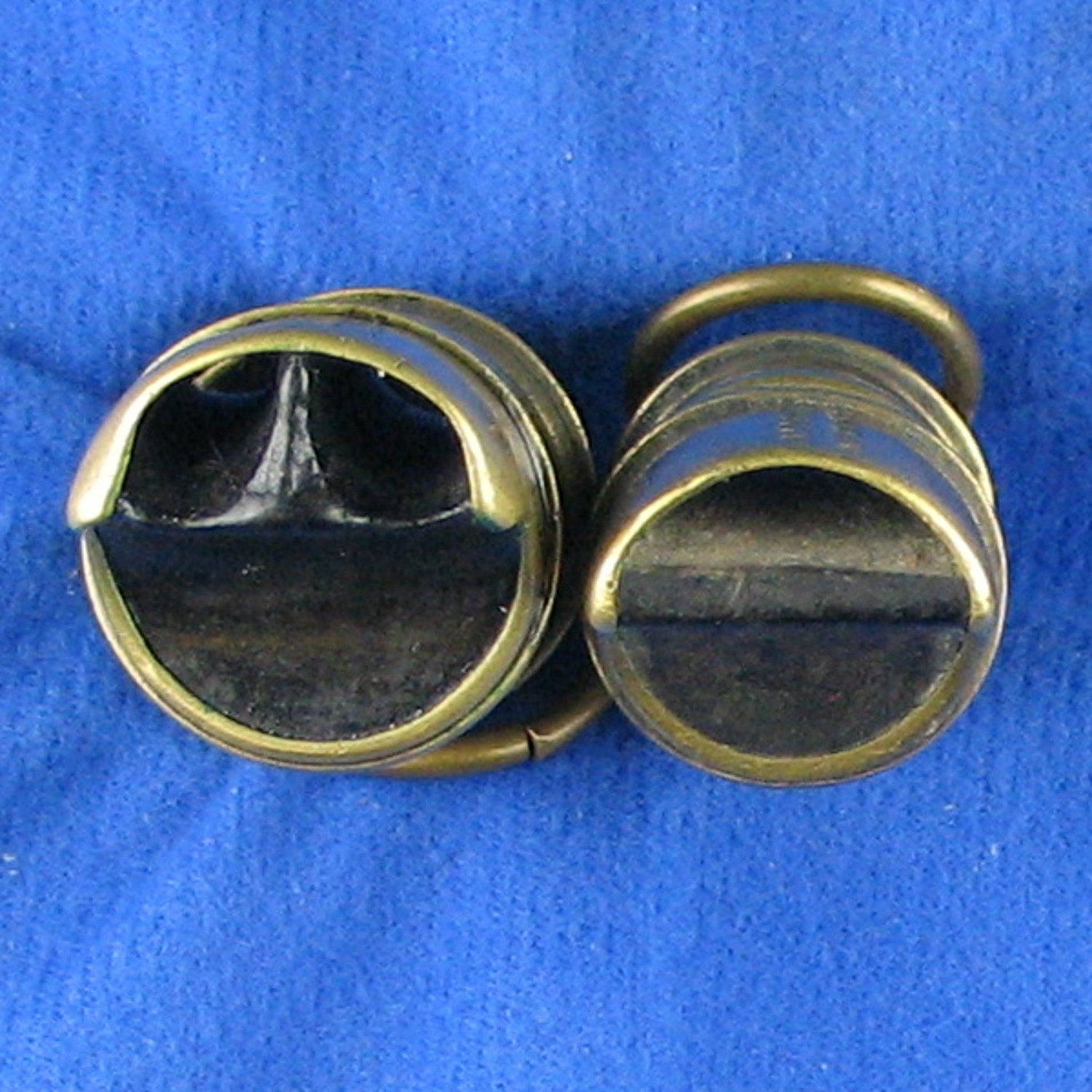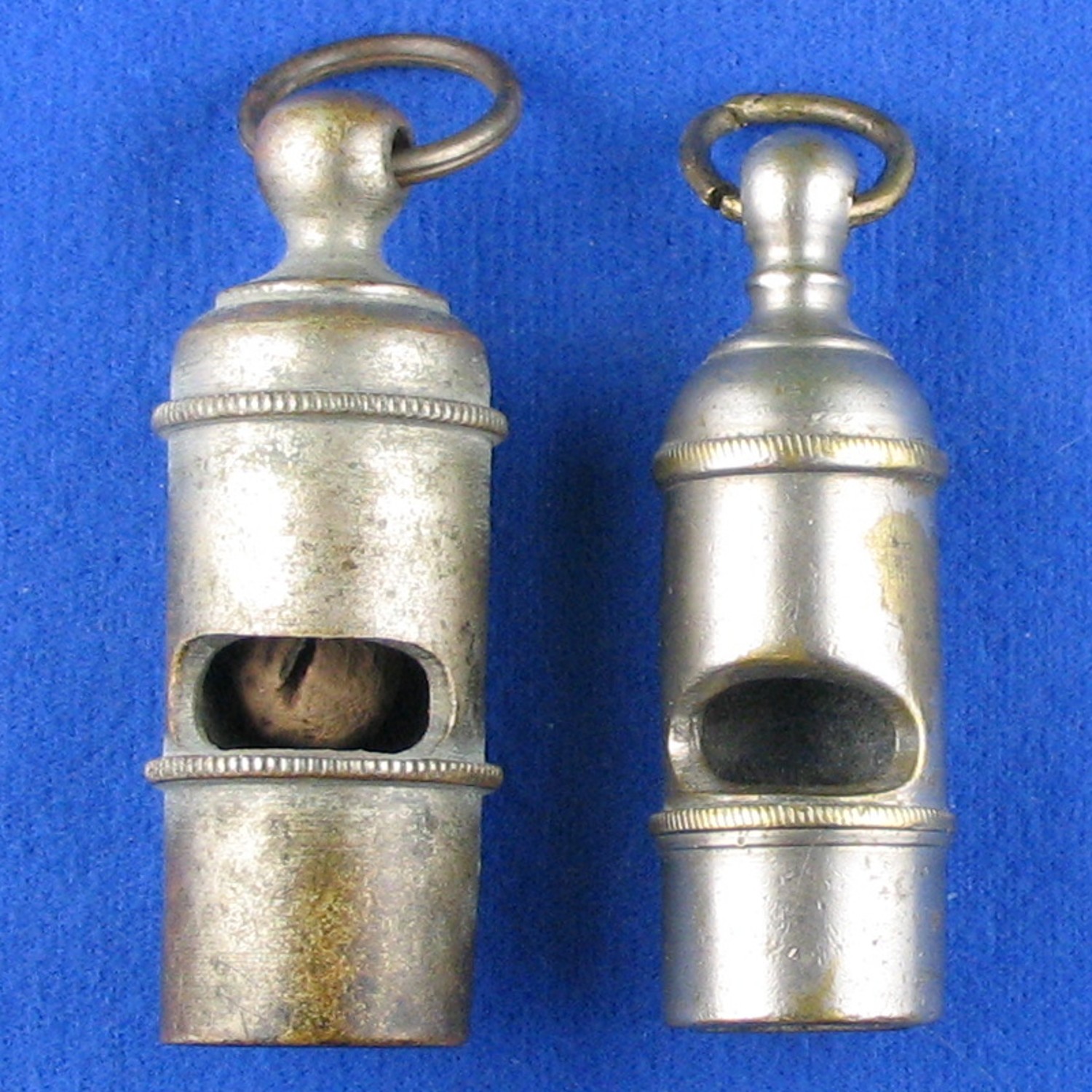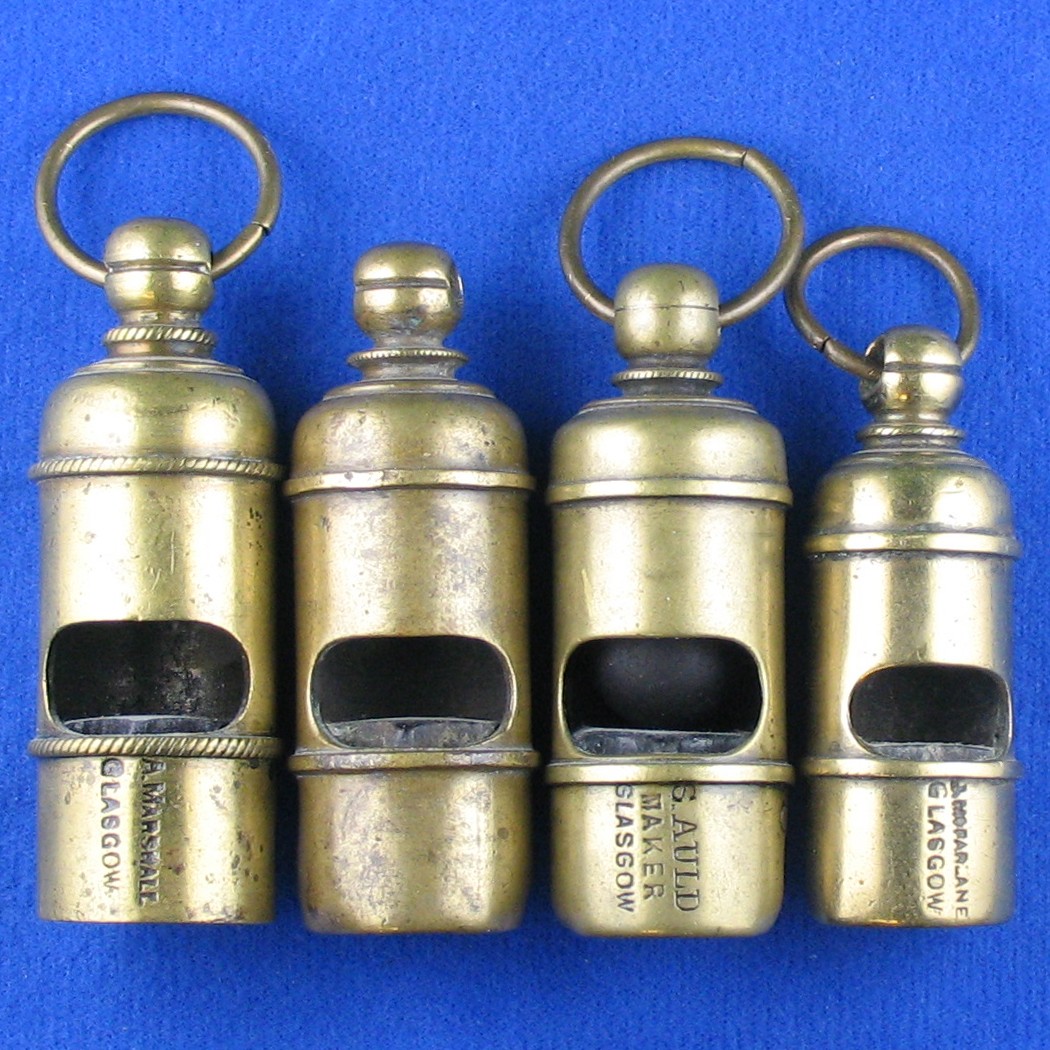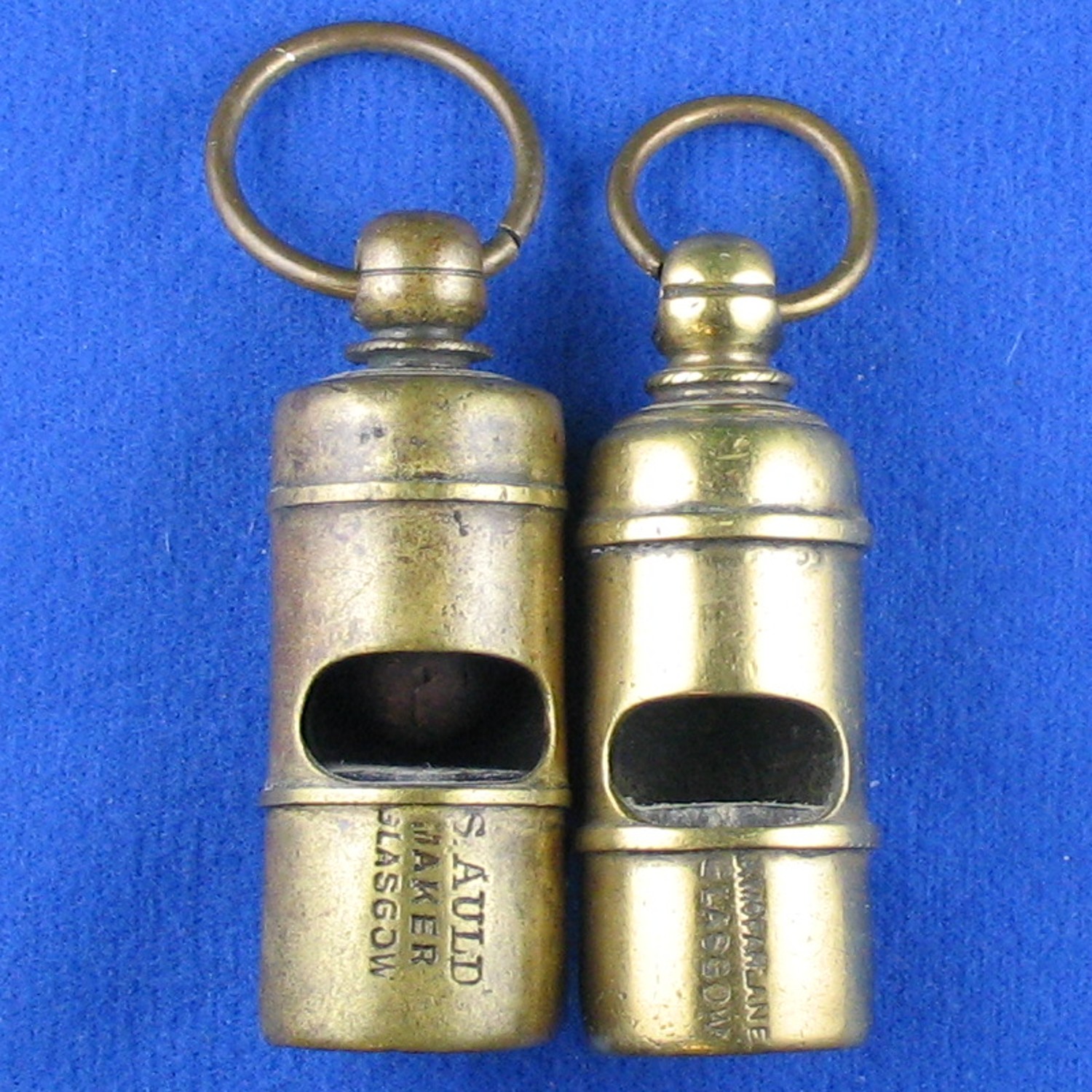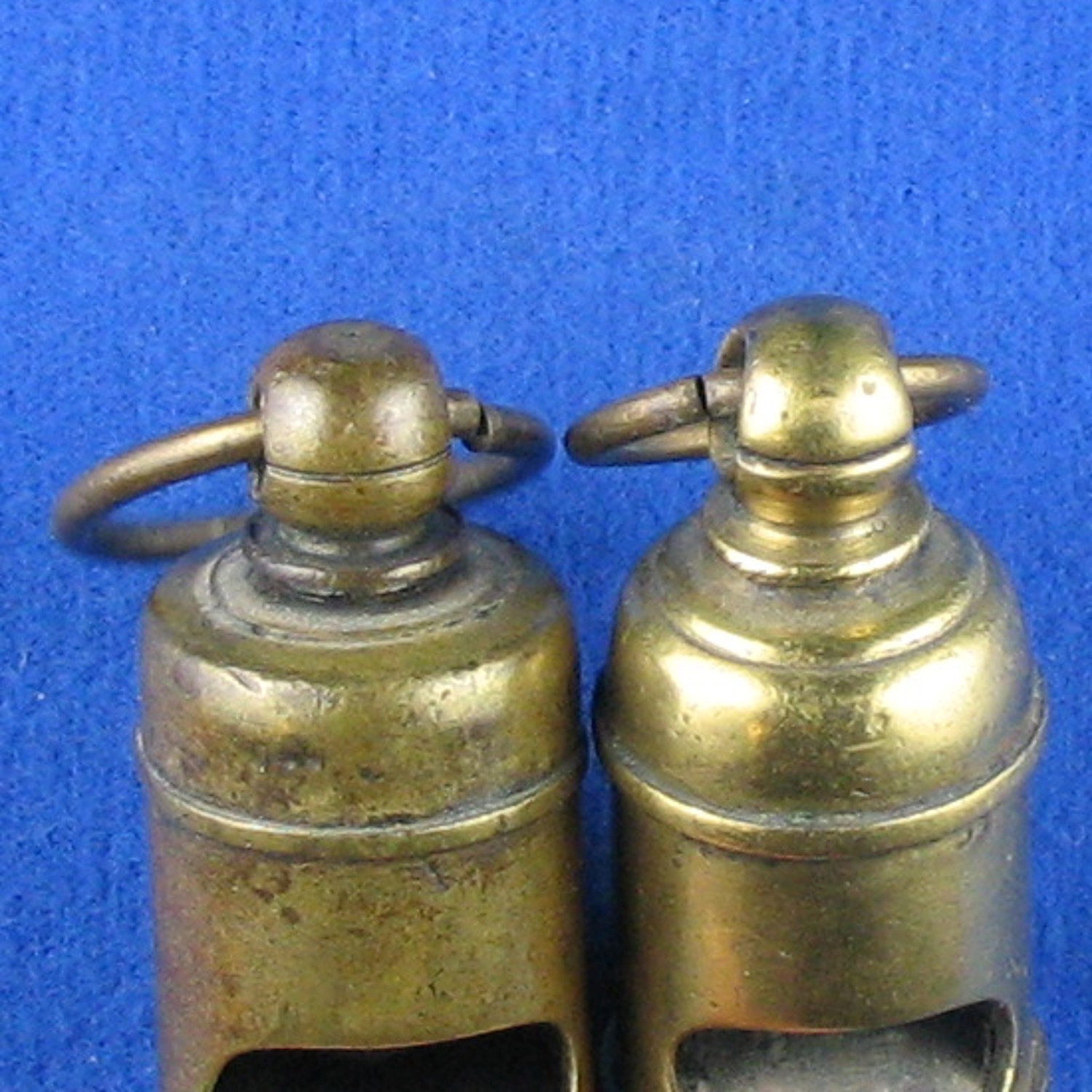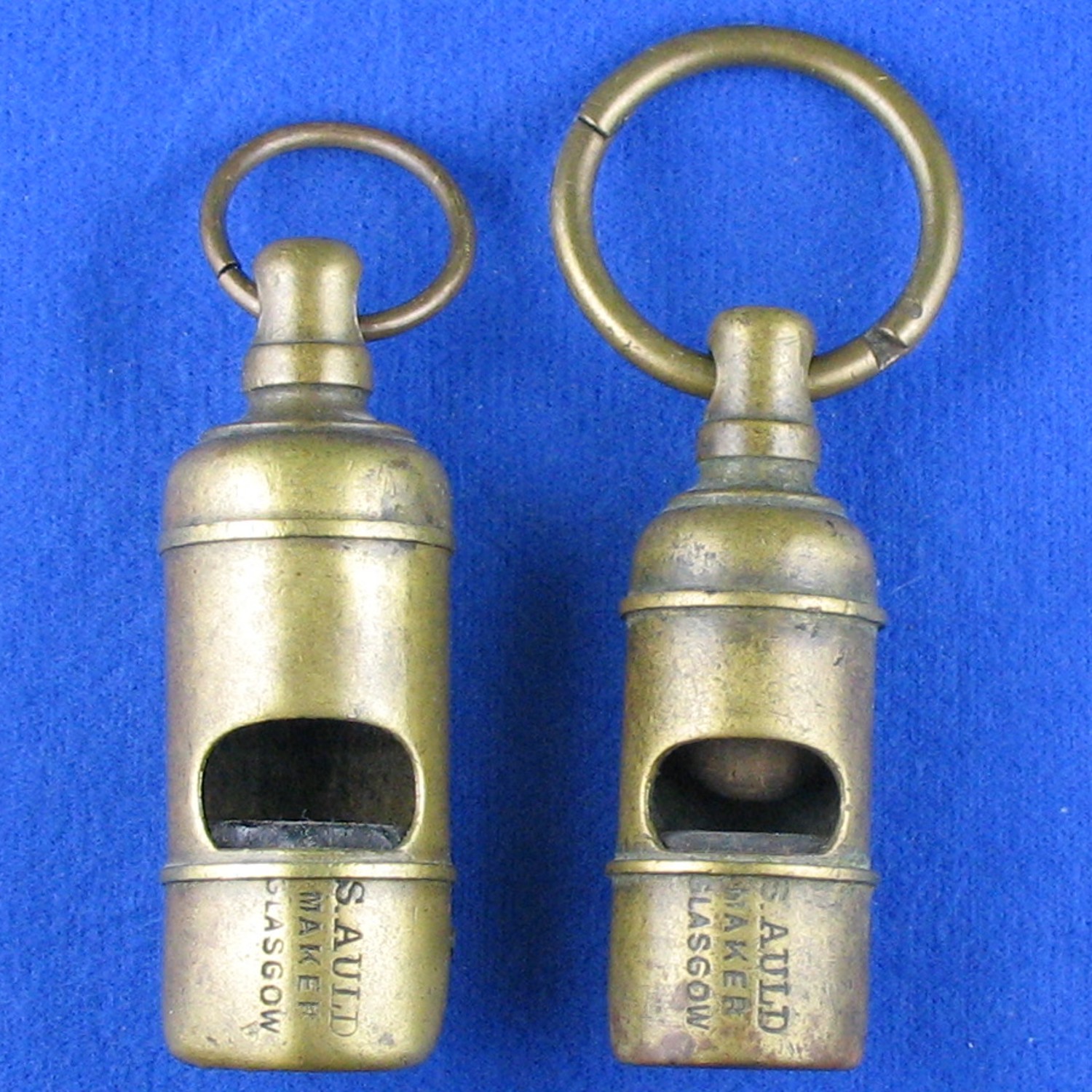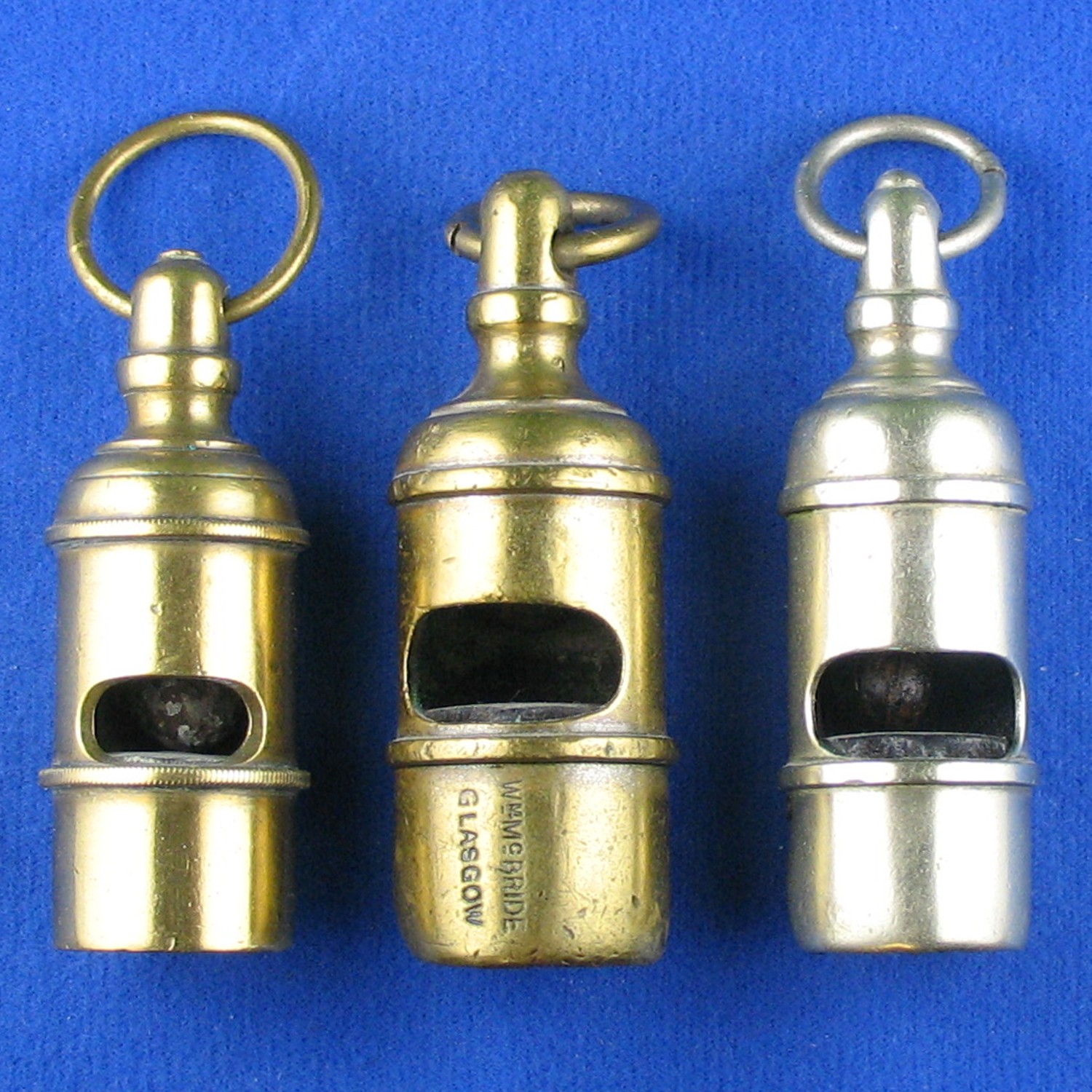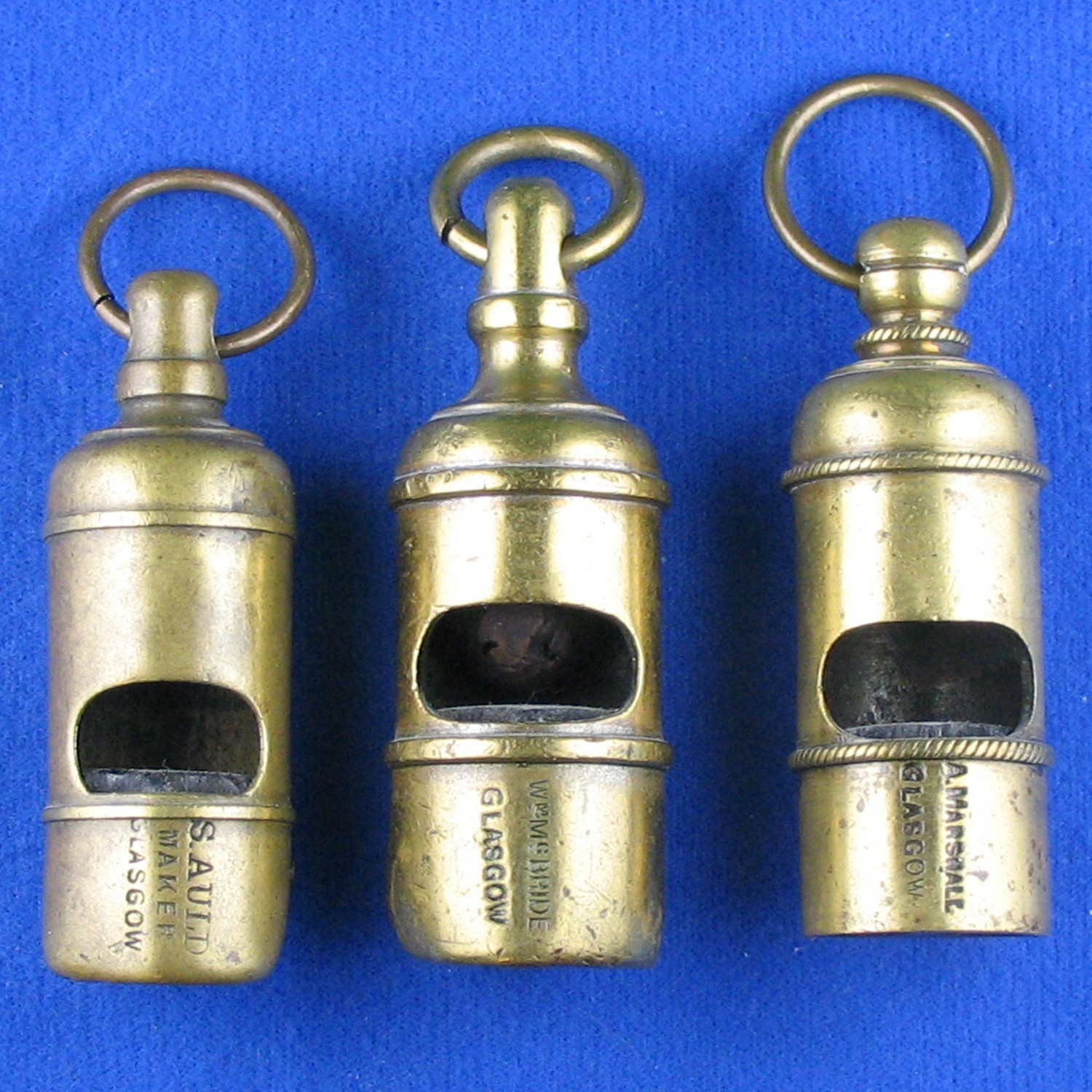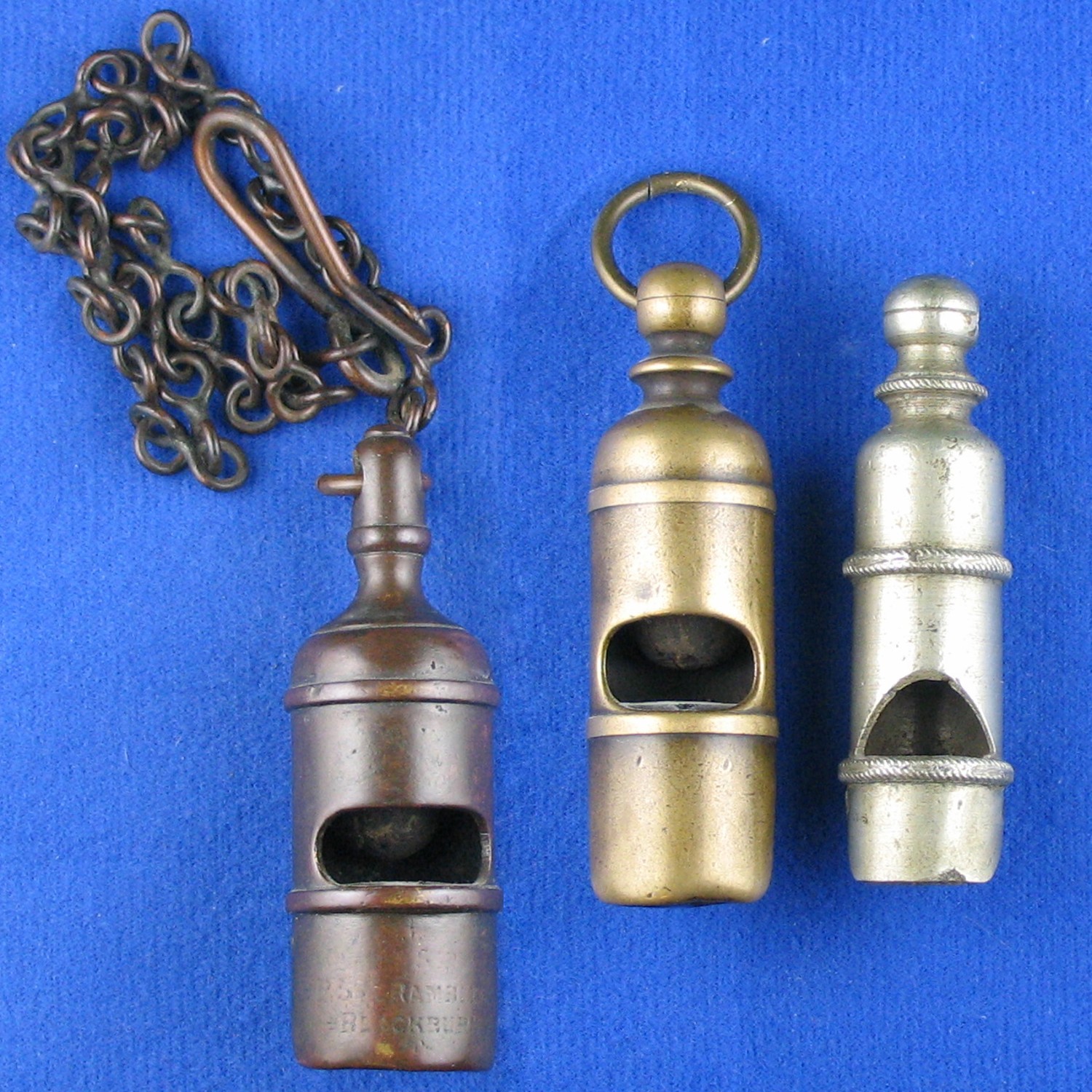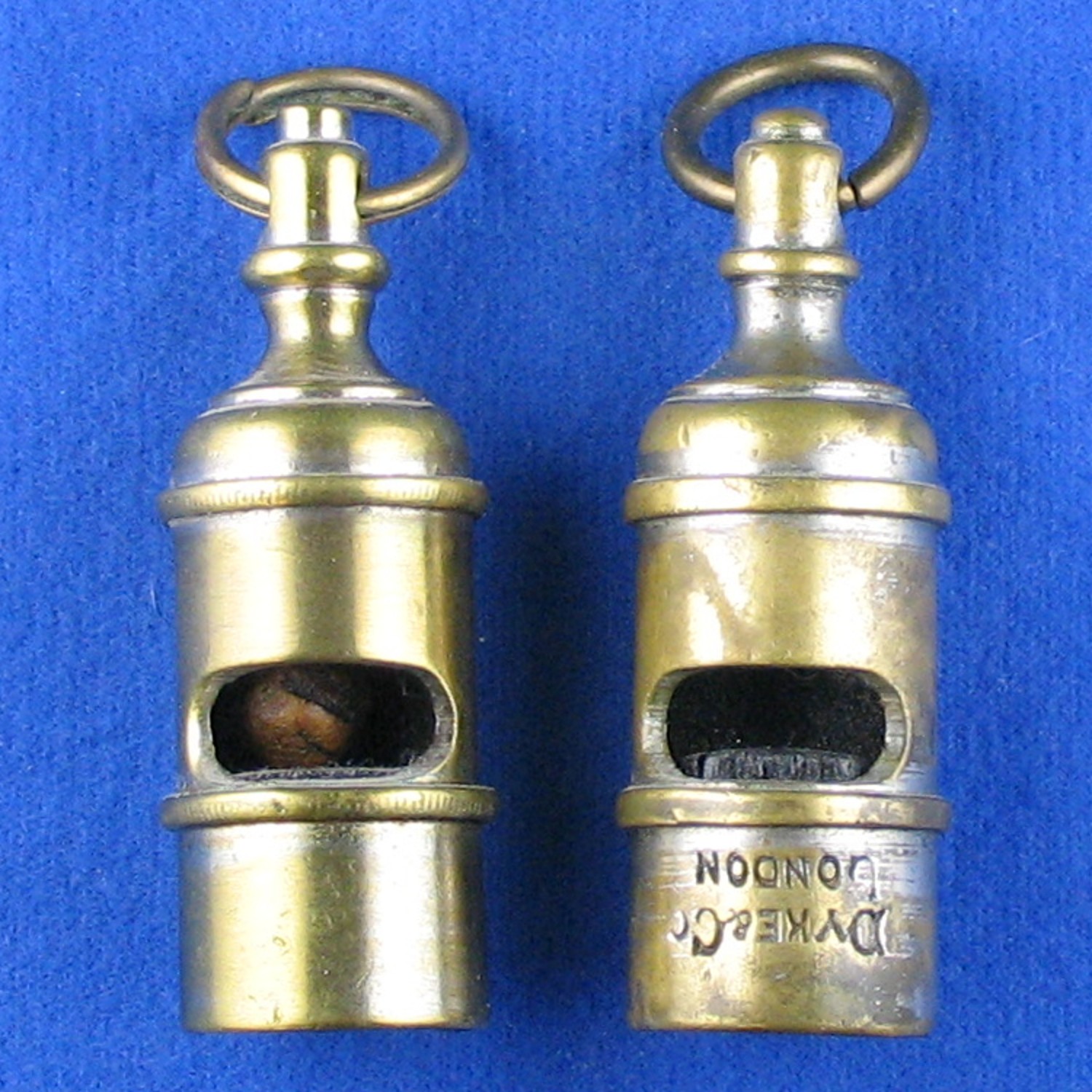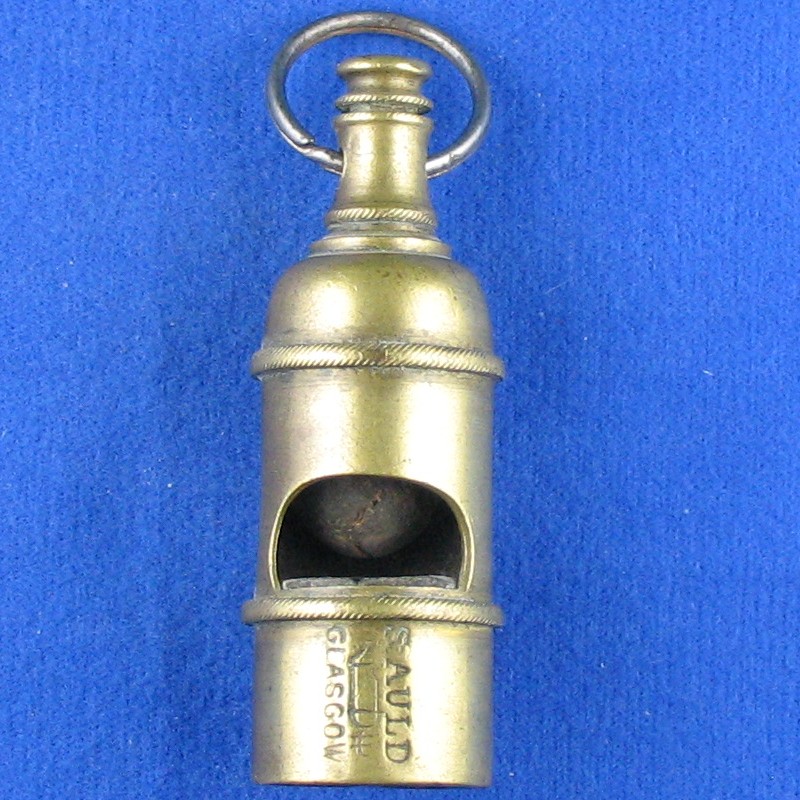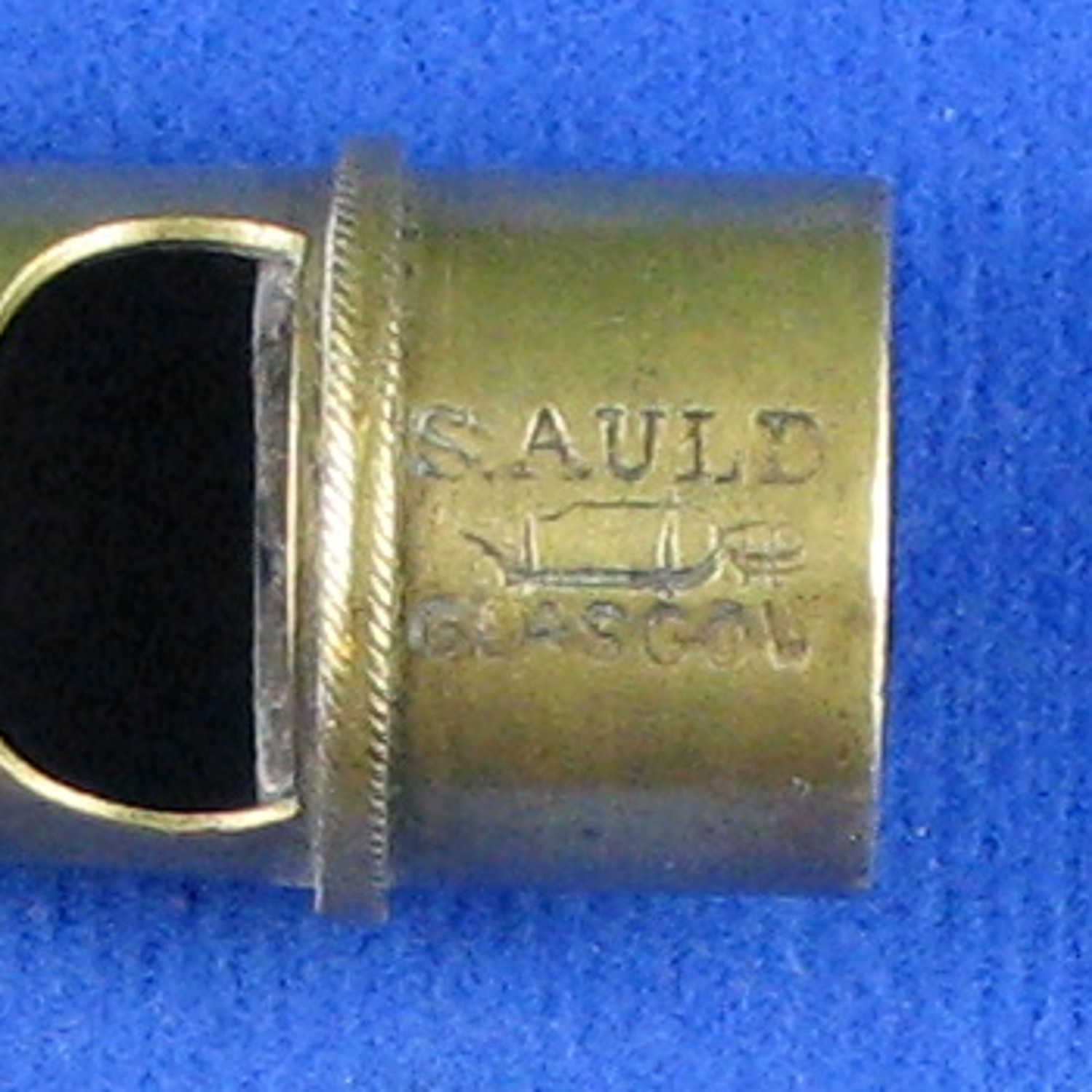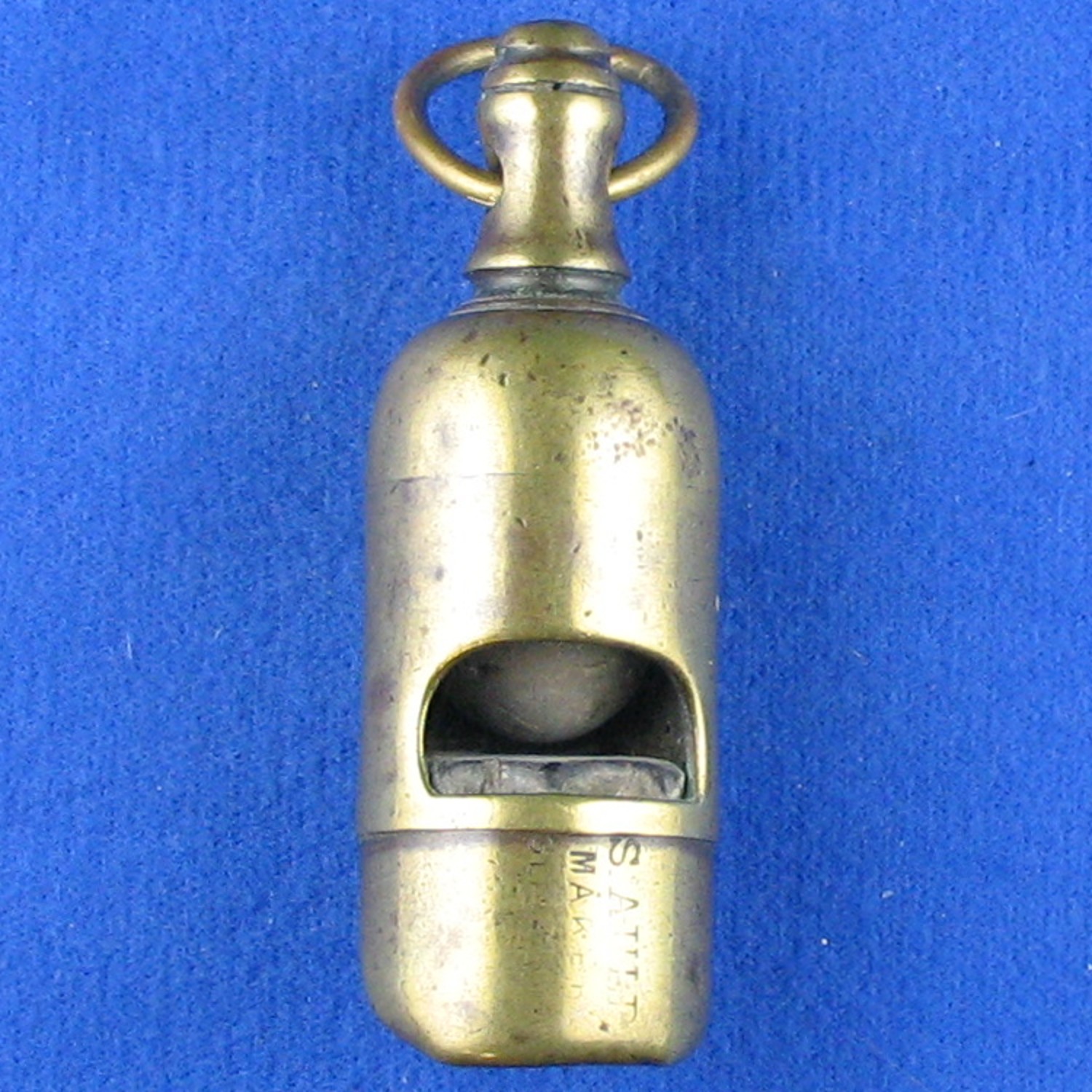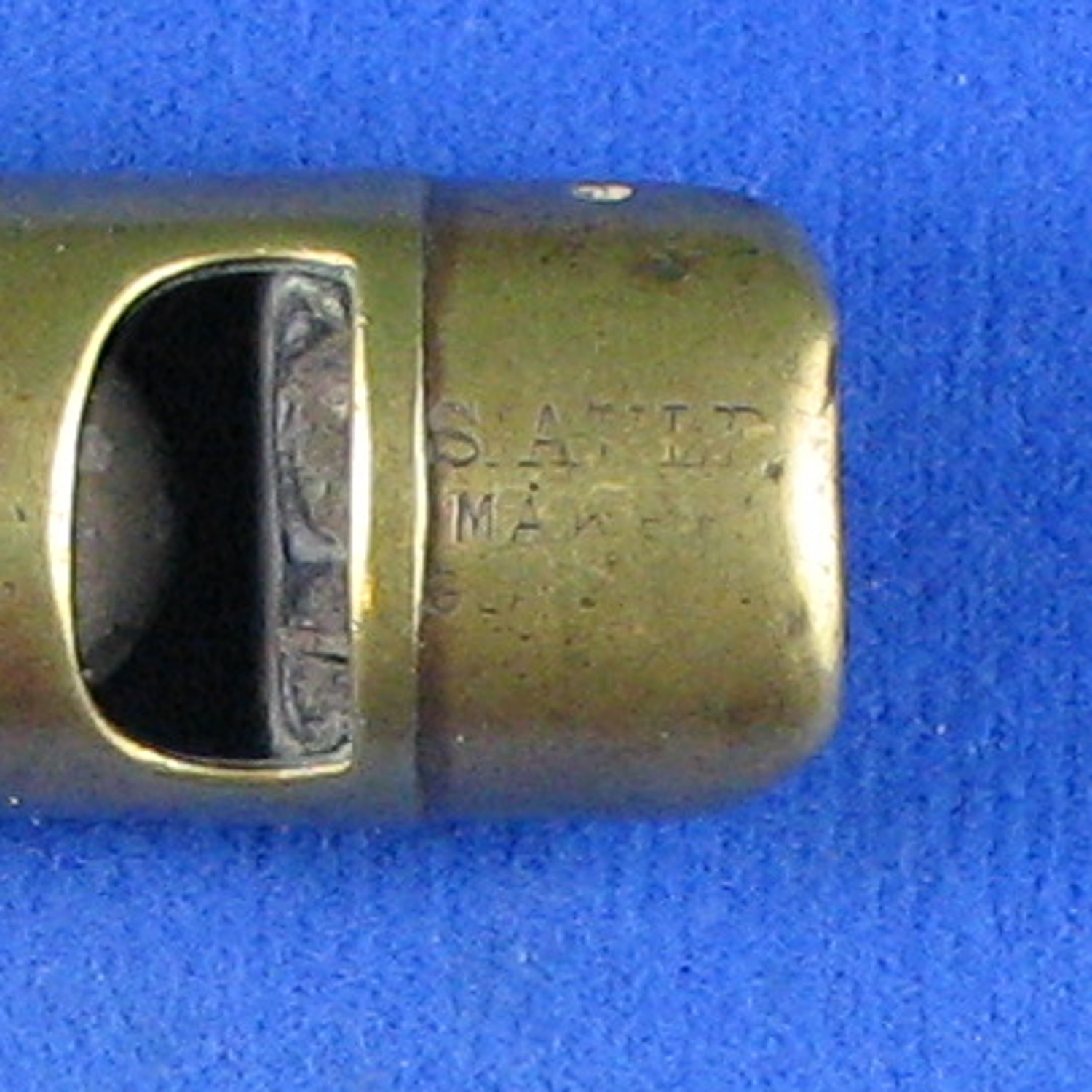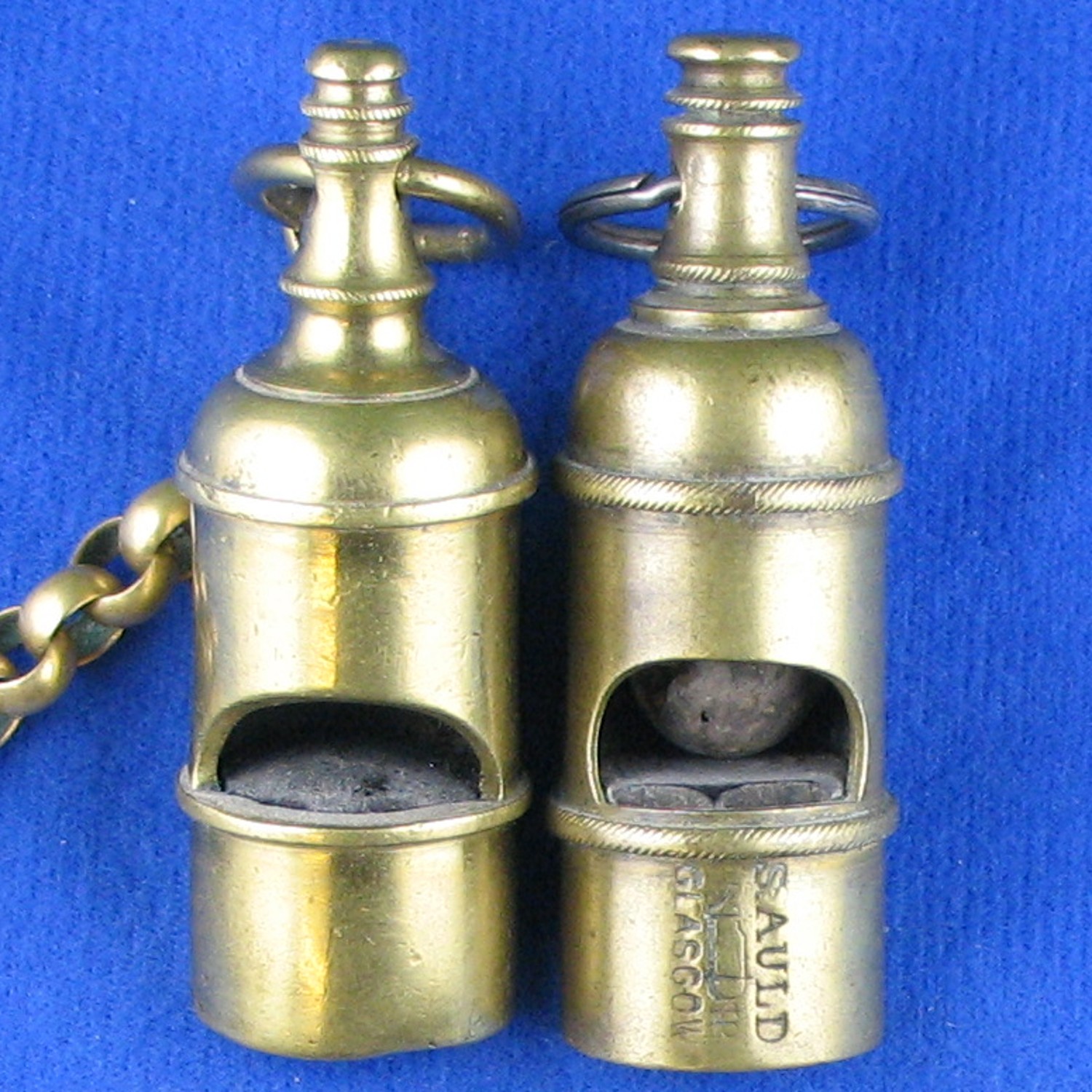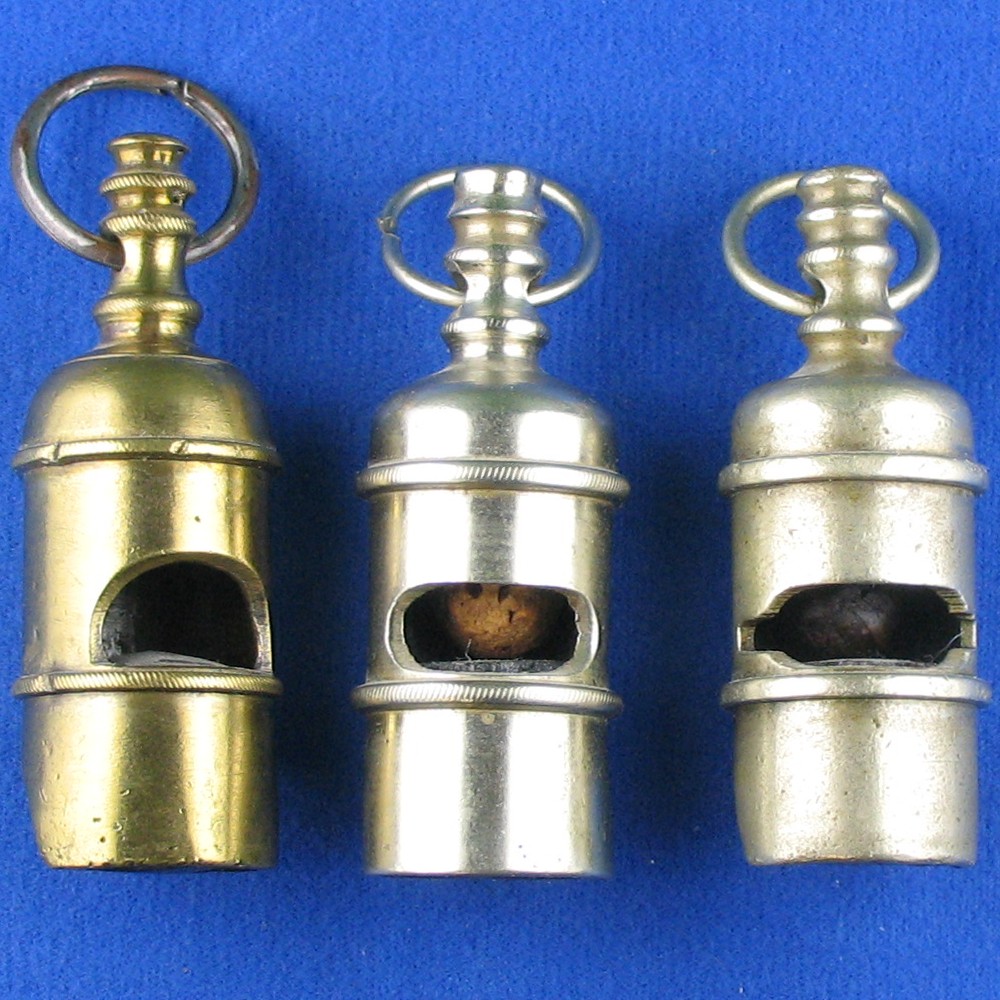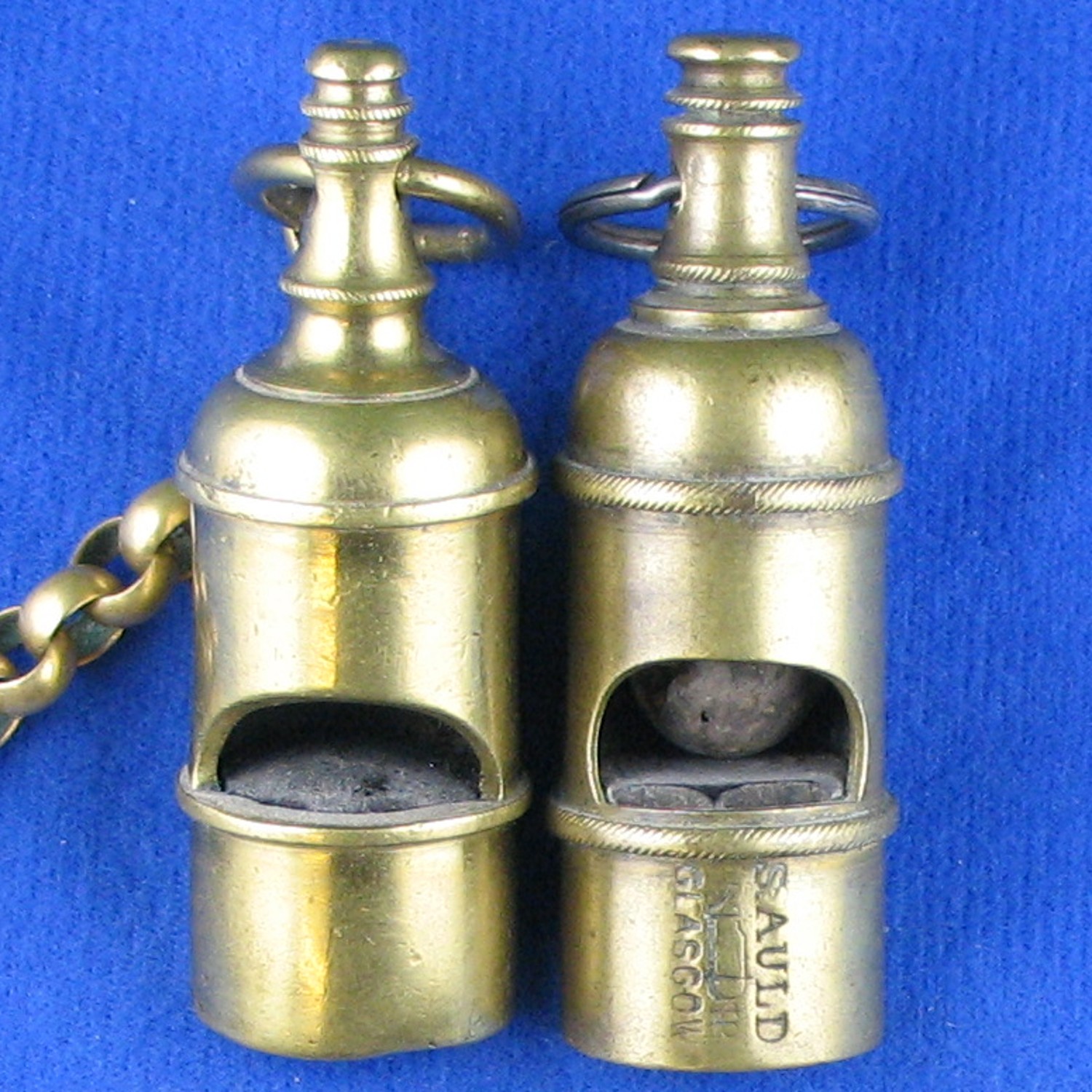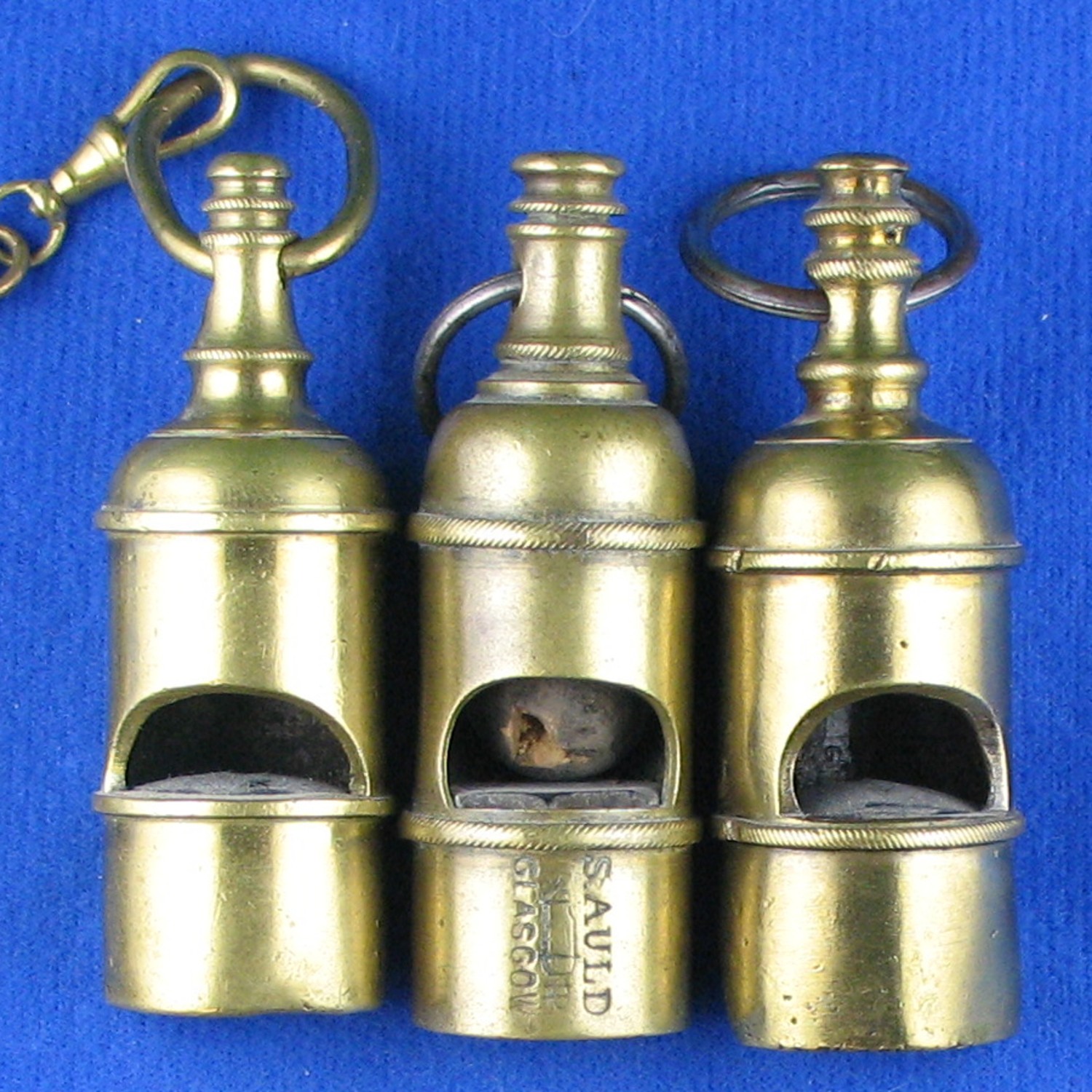Spotlight > Specific Manufacturer > United Kingdom > Auld > 051
The large amount of information covering Samuel Auld and Company whistles has created the need to be recorded in two parts. Escargot whistles that were registered in 1890 comprise part one. Part two is dedicated to round whistles, circa 1877 to 1907.
The rounds in themselves will include two parts A and B. Part A will be the heavy standard rounds commonly seen with round knops. Part B will be heavy rounds rarely seen with pillar tops. Pillar top Auld round whistles have not as yet been duly recorded and studied. Here will be presented some original identification and comparisons for the collector and students of rare whistles.
PART A – ROUND TOPS
Stamps are seen that confuse collectors when they see ‘MAKER’ coupled with a distributor name — but also merely stamped with names such as:
Plunkett
J McFarlane
J. Christie
A. Marshall
J Reid
Westwood
Glasgow Police Call
McN & W
S. Auld
Wm McBride
There was a curious practice of stamping MAKER next to a distributer, not reserved to Auld. ( please note Beech/Auld in part one also ) However stamping a distributer name was quite common.
In manufacturing these heavy round whistles which were drilled out from solid rod, a characteristic window in an oval shape emerged and became a hallmark of Auld and Company, thus setting a standard that would follow them and others — the nickname as Auld ‘type’ windows.
Three other companies ( i.e. Hudson, Ward and DeCourcy ) would use this feature. There are some rounds that defy identification using this feature and there may well be other makers involved.
The ring around the knop is known to have been used not only by Auld, but also by Yates, Linegar, DeCourcy, Barrall, Dixon and perhaps others which make it less useful for identification.
Auld utilized two kinds of fipples. Most models had two holes, some utilized one straight edge.
To date a metal fipple has not been identified with an Auld round . In fact, only one Auld ‘type’ window round whistle has been found here with a metal fipple.
All others in this article have wooden fipples. The round pictured below to the right has the metal fipple.
Auld rounds came in four sizes. Perhaps this was on purpose, but more likely due to the handmade manufacturing. There are some that fall outside of these four.
Some have square shoulders; most have rounded ones as seen below.
In 1907 when Hudson purchased Auld’s stock they started at some point to make their own rounds with Auld’s name stamped on them. They can be recognized by the short pillar top. We have found them in two sizes.
Alfred DeCourcy also made rounds that looked like Auld. He used the pillar top like Hudson’s, but used a bulky heavier pillar. He also utilized the oval window and even placed the stamp in the same place.
Take note of the Auld, Hudson and DeCourcy side by side. Can you pick out which is which ??
Now let’s look at some ‘Auld like’ rounds with the same oval windows. One has a curved window but Auld like knop.
The first three are unidentified, the first possibly Ward. The last two further below are probably DeCourcy,.
Not easy to discern is it ? That is the fun of hunting down the manufacturers and looking for clues to do so.
PART B – PILLAR TOPS
A remarkable and KEY whistle appeared a few years ago and lays the groundwork for this section of study.
Several things are of particular note.
First the pillar top. Previously attributed to Auld because of the window, was still not for sure. However with Auld’s stamp it makes it a wonderful stepping stone to identifying others.
Second is the remarkable shape of a pillar top whistle in the stamp that cements the picture of this model.
Lastly the window is a change from the oval and now helps in that direction also of identification of other non oval rounds.
Then another appeared much more worn and smoother shaped, also stamped.
The pillar seems to be production oriented. However as we shall see it is not definitive.
Where we run into difficulty is the next series.
The first is brass and the seat of the pillar is applied. However the pillars in the two nickel silver whistles are all crafted as on piece from rod.
The first brass round matches the Auld’s. Let’s compare just those two.
The windows don’t match. The pillars are close. The windows definitely different.
Next we look at three nickel silver round with the tops all smooth and solid from tip to tip.
The cut of the second round ‘s window is quite rare and unique. However it would still fall within the arena of ‘Auld like’ windows.
Lastly we bring in Linegar and compare the classic Linegar top to an Auld pillar.
Quite similar and confusing at the same time and we ask who influenced who ?
For students of rare antique whistles the challenges are there. The end will be left open on the article as usual to allow for more discoveries.
TWG
Posted November 5, 2015
ADDENDUM:
Posted March 5, 2018
SAMUEL AULD
Samuel Auld was born in Ireland in about 1838. Some time prior to 1860, he elected to migrate to Scotland in search of work and a better life, as many Irish did during this time.
The first recorded information of his presentence in Glasgow, Scotland was his marriage to Mary Ann Donaldson in 1860. The 1861 Census gave an address of 72 Moore Street. It is believed that this is his residence address instead of his work address. His occupation was listed as a card grinder. A card grinder performed equipment maintenance for the equipment used in the weaving of wool in the textile mills of that era.
An 1877 record shows Samuel Auld in business as Auld & Westwood, brass founders and gasfitters at 248 Gallowgate Street . The Edinburgh Gazette on November 2, 1877 states the partnership business of Samuel Auld and John Westwood known as the Globe Brassfoundry was dissolved by mutual agreement on July 20, 1877. How long the partnership actually lasted is up for debate. Some have suggested this relationship lasted for up two years, but the recorded history available would support little more than about six months.
Auld remained at the 248 Gallowgate address providing services as a brass founder and gasfitter until 1878 when he changed location of the business to 240 Gallowgate. At the same time, he expanded the business to include the following services: general brass founders; gasfitters; bell ringers, and the celebrated police calls, railway guards, and points men’s whistles. The comments about the calls and whistles would certainly suggest that these products were developed or designed sometime before 1878. (ergo at least 13 years prior to his 1890 registered design escargot and possibly while working with Westwood )
In 1880, Auld again expanded his operations into a second location. He also added the additional service of “plumbers” to those already existing. He was now housed at 240 and back into 248 Gallowgate, perhaps employing John W. Westwood. Samuel Auld remained at these two locations up to 1892.
In 1884 he added the services of “sanitary engineers” to his growing list of offer services.
In 1887, Auld listed the following available services: Plumbers; brass founders; gasfitters, bell hangers; all kinds of castings, etc.; beer pumps, bottling machines, beer and spirit cranes; shop fittings, and manufacture of the celebrated police calls, railway guards’ and point men’s’ whistles.
In 1889 Auld’s service listing were reduced to the following: whistle manufacturers and makers of the new improved police call, railway guards’ and point men’s’ whistles.
1890 Auld listed services as: whistle manufactures and contractors to the principal railways and tramways throughout the United Kingdom; sole makers of the improved whistle now adopted and registered. ( this was an escargot shaped whistle now )
1892 saw the shortest and least descriptive listing of services. It simply read “wholesale manufactures” and he moved the company to the single location of 240 Gallowgate, abandoning the 248 location.
1893 saw services better described as: whistle manufacturer and brass founder, located at the 240 Gallowgate address.
In 1895-1896, Auld established two separate companies with the same name at the location of 368 Gallowgate. The first company provided services as whistle manufacturers, the second company or division provided plumper services.
In 1897, it appears Auld again entered into a partnership, this time with David M’Gill Smith, who was an electro-plater. They moved their operation to 7 and 9 Wood Lane, Broomielaw. Auld and Company is now listed as two separate companies or divisions, one providing services as a whistle manufacture; brass founders; grinders; and polishers. The other business offered services as electro-platers and polishers
In 1902, the two Auld and Company organizations moved their operations to a single location at
54 Cowcaddens Street. One of the elements listed services as a whistle manufacture; brass founders; grinders; and polishers. The other element listed services as electro-platers; gilders; and nickel platers.
In 1905, Auid had altered the first company or division to change services offered to: whistle manufacturers; brass founders; bronzer; and lacquerers. Second company’s services remained the same.
The Edinburgh Gazette, June 22, 1906 stated that the co-partnership of Samuel Auld and David M’Gill Smith had dissolved on February 27, 1906.
Some say that Samuel Auld and Company had gone bankrupt. This does not appear to be the case. Auld had proven to be an excellent business man, expanding services when they were profitable, and reducing services that proved to be unprofitable. He changed the size and location of his company as the business economy dictated. In 1906, Samuel Auld would have been 68 years old. He and his wife had moved in with his daughter and son-in-law at their
92 South Portland Street address in 1901. He had no male heir to carry on his company. He may have been sick, but certainly ready for retirement. It appears that is what he did after selling his equipment, etc. to Hudson. Samuel nor his wife appear in any of the Death Census issued each year by the Scottish government, nor do they appear in Scotland’s last available census of 1911. One can checked the index through the year of 1940. Samuel and Mary Ann Auld simply vanished after 1907.
FAMILY HISTORY
Samuel Auld Birth – c.1838 Ireland D: Unknown
Mary Ann (Donaldson) Auld (wife) B. 1841 D: Unknown ( Married: Scotland 1860 )
Elizabeth Auld (daughter) B. 1861 D. 1929
James Hart (son-in-law) B. 1858 D. 1915/16
Annie Hart (granddaughter) B. 1884 D. Unknown
James Hart (grandson) B. 1889 D. 1914 (WW1)
ADDRESSES
1861 72 Moore Street Occupation: Card Grinder
1877 248 Gallowgate Street – Globe Brass foundry ( dissolved )
1878 240 Gallowgate Street
1880 240 & 248 Gallowgate Street
1881 Occupation: Brass Founder, employed three men.
1891 132 Duke Street (home address )
1893 240 Gallowgate Street
1895 368 Gallowgate Street – 2 separate businesses
1897 7 & 9 Wood Lane whistle manf., brass founders, grinders and polishers
1901 92 South Portland Street Occupation: Brass Founder (Samuel and wife living with
daughter and family) – personal home address
1902-06 54 Cowcaddens – business address – dissolved partnership Feb. 27 1906 )
Sells out to Joseph Hudson 1907.
Archives.com
-TWG
ADDENDUM:
Posted March 5, 2018
JOHN WILLIAMSON WESTWOOD
Before we get into John’s own history, we need to discuss the life of his father, James Westwood.
James was born in New York in about 1830. He moved to Scotland sometime before he married Janet Williamson on Dec 24, 1852. The following census lists their home address and his occupation at that time:
1861 27 Tylefield Occupation: Iron Moulder
1871 2 William Street Occupation: Brass Moulder
1881 75 Dawson Street Occupation: Tinsmith
1882 26 Westmuir Street (Postal Service) Occupation: Tinsmith and Gas Fitter
1891 492 Gallowgate Occupation: Tinsmith
James and Janet had a total of eight children. Five of them were sons. Their names were Margaret, Robert, Sarah, Janet, James, Alexander, John, and Thomas. Please note no son by the name of Andrew. Thomas was 2 years older than John; James was 2 years younger, Alexander was 7 years younger, and Robert was 9 years younger than John.
The Scottish Postal Service provides the following information on James:
1878 Westwood and Sons, tinsmiths & gasfitters, 24A Westmuir Street, Parkhead
1882 Westwood, James, tinsmith and gasfitter, 16 Ewing, Parkhead; home, 26 Westmuir Street
1884 Westwood, James, tinsmith and gasfitter, 16 Ewing
James died in 1895.
John Williamson Westwood’s History:
John was born Feb 26, 1856. His middle name came from his mother’s maiden name. John died Feb 23, 1886 from Typhus
He married Agnes Kirkwood in 1878. They had 5 children named: John, William, Thomas, Agnes, and James.
1861 27 Tylefield 5 years old
1871 2 William Street Occupation: At 15 his occupation is listed as Engraver (with father)
1881 158 Salamanca Street Occupation: Master tinsmith employing 2 Boys
1883 22 Gray Lane
The Edinburgh Gazette, dated November 2, 1877 states that the Copartner ship carrying on business as the Globe Brass Foundry located at 248 Gallowgate was dissolved by mutual agreement on July 20, 1877. This partnership was composed of Samuel Auld and John Westwood.
The Scottish Postal Service provides the following information on John:
1877 Auld & Westwood, brass founders and gasfitters, 248 Gallowgate
1878 Westwood, John, brass founder, 248 Gallowgate
1878 Westwood, Andrew, brass founder and gasfitter, 248 Gallowgate; home 48 North Portland
Street (Looks like John and Andrew are attempting to keep part of the company going
after the Auld/Westwood split up in the summer before. Auld moved his operation to 240
Gallowgate. By 1980, Auld had reclaimed the 248 Gallowgate address as well as the 240
Gallowgate address.}
1879 No listing
1880 No listing
1881 No listing
1882 Westwood, John Tinsmith and gasfitter, 46 Westmuir, Parkhead
1883 Westwood, John Tinsmith and gasfitter, 46 Westmuir, Parkhead, home 22 Gray Lane
1884 Westwood, John Tinsmith and gasfitter, 46 Westmuir, Parkhead
1885 Westwood, John Tinsmith and gasfitter, 46 Westmuir, Parkhead
1886 Westwood, John Tinsmith and gasfitter, 46 Westmuir, Parkhead
John’s wife ran this business after his death for at least two years.
Comments:
J.M. Westwood appears only twice in research. In the General Directory of 1873, he is listed as a tinsmith and gasfitter, 73 Cumberland Street, Calton. In the 1873 Trades Directory he is listed in the Tin-Plate Worker and Merchants category.
Although round whistles made by Samuel Auld have been attributed to John M. Westwood, it would appear dubious at best. In fact John M. Westwood would appear to be an entirely different person altogether than John W. Westwood. This assumption is based on a clipping from 1872 of John M. Westwood.
In 1872, John W. Westwood would have been merely 16 years old, just one year after being listed as living and working with his father as an engraver.
It seems unlikely that he would have had the resources to own a company at that time ( i.e.1872 ), certainly incapable as an engraver , of manufacturing high quality whistles of solid rod brass and ebony fipples. In fact if he had any capability as a whistle maker, it was never seen again after leaving the partnership with Auld.
In 1876-77, he became a partner in business with Samuel Auld. This partnership was short lived. What is interesting though, it appears that Auld moved to another close by address after the partnership broke up in July 1877 and John remained at the 248 address as a Brass founder. He was joined by another brass founder named Andrew Westwood. This was not
John’s brother, unless they got the first name wrong.
We know Auld returned to 248 Gallowgate as a second address for his company in 1880. There is no listing for John in 1879, 1800, and 1881. No listing for Andrew at all after the first notation. It is possible that John and Andrew remained as employees of Auld until 1882, and maybe Andrew continued to work for Auld for a period after. James’s address in 1882 is 26 West Muir Street, while his son John is listed as working as 46 West Muir Street.
-TWG
Special thanks to Dan Shouse for his research and contributions to the research of both Addendums on Samuel Auld and John Williamson Westwood.
